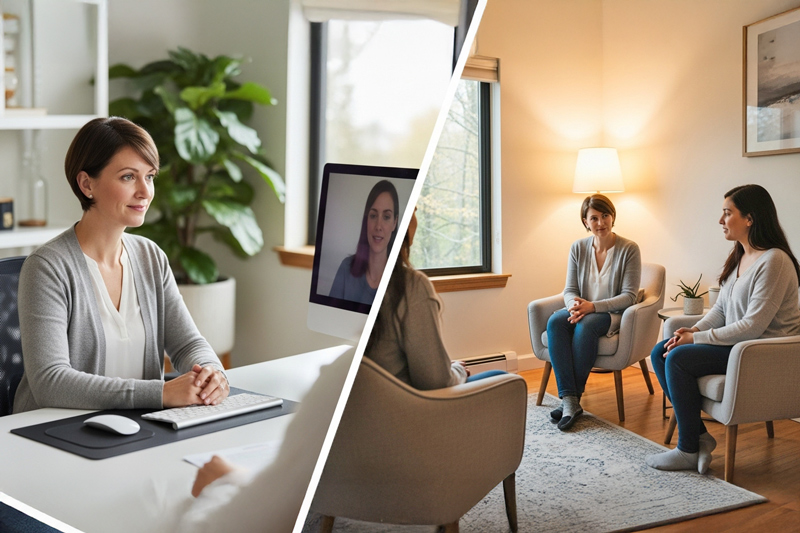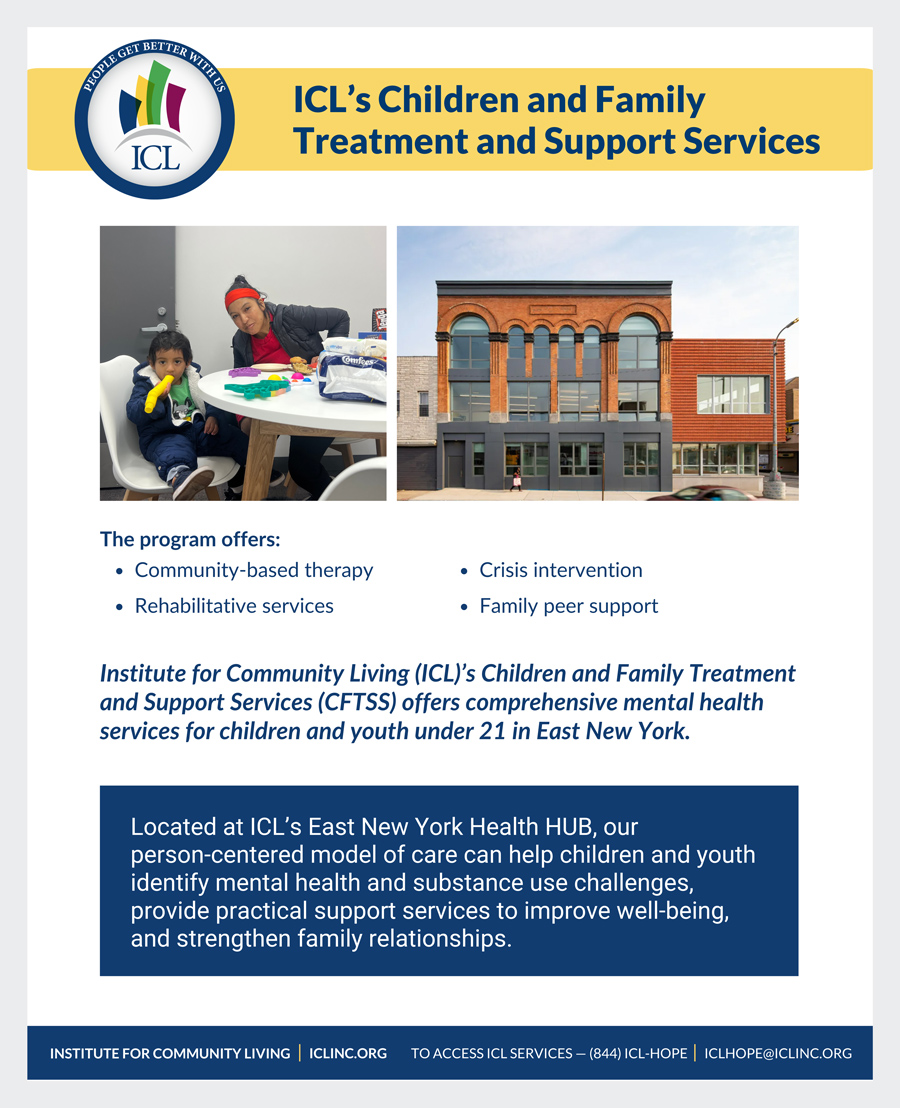Telehealth has transformed the delivery of psychotherapy, particularly in the treatment of anxiety disorders. This article examines evidence comparing telehealth and face-to-face therapy outcomes for anxiety, explores therapeutic modalities effective in each format, outlines best practices for diagnostic assessment, and provides comprehensive clinical recommendations. Current research demonstrates comparable efficacy across modalities, with cognitive-behavioral therapy (CBT), acceptance and commitment therapy (ACT), exposure therapy, and mindfulness-based interventions adaptable to both telehealth and in-person settings. Additional focus is given to diagnostic strategies, clinician best practice tips, cultural considerations, crisis management (including licensure requirements), hybrid care models, and relapse prevention to optimize anxiety treatment outcomes.

Introduction
Anxiety disorders are among the most prevalent mental health conditions worldwide, impacting functioning, quality of life, and overall well-being (American Psychiatric Association [APA], 2022). Accurate diagnosis and effective intervention are essential, yet modality of care, telehealth versus face-to-face, raises practical, clinical, and ethical considerations for therapists. As telehealth expands rapidly in clinical practice, clinicians must integrate evidence-based strategies to ensure efficacy across both remote and in-person formats.
Best Practices for Diagnosing Anxiety
Telehealth Diagnosis – Telehealth assessments rely on structured interviews, validated self-report scales, and remote observation. Evidence indicates that diagnostic accuracy remains high when standardized tools are used via secure video platforms (Shore et al., 2018).
Recommended tools:
- Mini-International Neuropsychiatric Interview (MINI): Validated for DSM-5 diagnoses, adapted for telehealth.
- Self-report scales: Generalized Anxiety Disorder-7 (GAD-7), Beck Anxiety Inventory (BAI), and Overall Anxiety Severity and Impairment Scale (OASIS) are brief, validated instruments easily administered electronically (Spitzer et al., 2006).
- Child assessments: The Screen for Child Anxiety Related Disorders (SCARED) includes both child and parent reports, suitable for remote use.
Face-to-Face Diagnosis – In-person diagnosis benefits from direct behavioral and physiological observation.
Recommended tools:
- Structured Clinical Interview for DSM-5 (SCID-5): Gold standard clinician-administered tool (First et al., 2015).
- Clinician-rated scales: Hamilton Anxiety Rating Scale (HAM-A) and Liebowitz Social Anxiety Scale (LSAS) provide nuanced, observed ratings.
- Behavioral and physiological assessment: Observation of restlessness, avoidance, and somatic cues; biofeedback (e.g., heart rate variability) can corroborate symptom presentation.
Regardless of modality, multi-method assessment combining structured interviews, standardized scales, and functional assessment maximizes diagnostic validity (García-Carrión et al., 2022).
Evidence Comparing Telehealth and Face-to-Face Treatment
Symptom Reduction and Outcomes – Meta-analyses confirm telehealth’s clinical equivalence to face-to-face psychotherapy. Krzyżaniak et al. (2024) conducted a meta-analysis of five randomized controlled trials (RCTs) comparing telehealth and in-person interventions, reporting no significant differences in anxiety reduction, depression symptoms, or functional outcomes. Greenwood et al. (2022) similarly reported equivalent outcomes across anxiety and mood disorders, with high patient satisfaction and adherence.
Therapeutic Alliance and Satisfaction – Shaker et al. (2023) found that therapeutic alliance ratings in telehealth CBT were statistically comparable to those in-person. Despite reduced non-verbal cues, empathy, validation, and collaboration successfully translate across modalities.
Evidence-Based Modalities for Anxiety
Cognitive-Behavioral Therapy (CBT) – CBT remains the first line treatment for anxiety (Hofmann et al., 2012). Telehealth adaptations include screen shared worksheets and secure portals for homework review. Face-to-face CBT allows for in-season behavioral experiments and immediate feedback.
Exposure Therapy (ERP/In-Vivo and Interoceptive) – Exposure therapy is critical for panic disorder, phobias, and social anxiety (Craske et al., 2014). Telehealth supports therapist guided remote exposures (e.g., virtual coaching during feared tasks), while in person sessions permit therapists accompanied in-vivo exposures and controlled interoceptive exercises.
Acceptance and Commitment Therapy (ACT) – ACT emphasizes mindfulness and values-based action (Hayes et al., 2016). Telehealth allows for digital metaphors (e.g., shared-screen exercises), while in-office sessions enhance somatic grounding during acceptance exercises.
Mindfulness-Based Interventions (MBIs) – Mindfulness Based Stress Reduction (MBSR) and Mindfulness Based Cognitive Therapy (MBCT) reduce worry and improve emotion regulation (Khoury et al., 2013). Telehealth can leverage guided audio, while in-person work allows for therapist observation during practice.
Treatment Planning and Case Conceptualization:
- Use structured frameworks (e.g., CBT models) in both modalities.
- In telehealth, share visuals (screen-shared diagrams) to co-create case formulations.
- In-person allows for richer relational and non-verbal data to inform conceptualization.
Measurement-Based Care (MBC) – Routine monitoring using validated tools (e.g., GAD-7, OASIS, SUDS) improves outcomes. Telehealth enables automated scoring and graphing within EHR systems, while face-to-face permits in session review and discussion of trends.
Best Practice Tips for Clinicians
Telehealth-Specific Best Practices:
- Establish a Secure, Professional Environment: Use HIPAA compliant video platforms and verify client privacy (APA, 2021; Shore et al., 2018).
- Enhance Therapeutic Presence: Compensate for reduced non-verbal cues with verbal empathy and visible facial expressions (Glueckauf et al., 2018).
- Structured Session Design: Use consistent session structure with screen-shared worksheets and agenda setting (Backhaus et al., 2012).
- Promote Engagement: Use interactive tools and shorten sessions if needed to reduce fatigue (Shore et al., 2018).
- Crisis Planning and Licensure Compliance: Document client location and emergency contacts each session; ensure licensure compliance with the client’s state of residence (APA, 2021).
- Cultural Adaptations: Assess technology literacy and offer accommodations for diverse backgrounds (Shore et al., 2018).
Face-to-Face Best Practices:
- Optimize Therapeutic Space: Create a calming, private setting conducive to anxiety reduction (Norcross & Lambert, 2019).
- Leverage Non-Verbal Cues: Observe posture, fidgeting, and other anxiety signs for assessment (Kazantzis et al., 2018).
- Facilitate In-Vivo Work: Conduct guided exposures and biofeedback supported interventions (Craske et al., 2014; Goessl et al., 2017).
- Deepen Alliance Through Presence: Use warmth, eye contact, and immediate feedback (Norcross & Lambert, 2019).
- Enhance Skill Generalization: Assign real world exposure practice between sessions (Kazantzis et al., 2018).
Crisis Planning and Safety Protocols:
- Telehealth: Confirm client’s location every session, document emergency contacts, maintain crisis intervention steps, and verify licensure jurisdiction (APA, 2021).
- Face-to-Face: Prepare de-escalation plans, access to medical support, and panic response strategies for acute anxiety.
Cultural and Diversity Considerations:
- Address privacy barriers in shared households for telehealth.
- Use culturally validated measures and integrate client’s coping traditions into mindfulness or relaxation practices.
Relapse Prevention and Maintenance:
- Develop relapse prevention plans with triggers and coping strategies.
- Use booster sessions (telehealth or in-person) to reinforce skills.
Hybrid/Stepped Care Models:
Hybrid approaches combine telehealth CBT for accessibility with periodic in-person sessions for intensive exposure or biofeedback. This flexibility tailors care for severity and logistics.
Conclusion
Anxiety treatment delivered via telehealth is evidence based and comparable to in-person care when clinicians utilize structured diagnostic methods, validated assessment tools, and evidence-based modalities. Telehealth excels in accessibility, while face-to-face treatment remains vital for severe anxiety, somatic work, and intensive exposure. By integrating measurement-based care, cultural adaptations, licensure compliance, crisis protocols, and hybrid models, clinicians can deliver effective, client-centered anxiety treatment across both modalities.
Richard Anemone, MPS, LMHC, holds a master’s degree in psychology and is a licensed mental health counselor in New York State. He owns Behavioral Mental Health Counseling PLLC, a private practice specializing in gambling addiction, anger management, intellectual developmental disabilities, and psychiatric disorders. He is also Senior Vice President of the IDD division at ICL, which provides comprehensive housing, healthcare, and recovery services to New Yorkers with behavioral health challenges. He can be reached at Richard.Anemone@BMHC-NY.com.
References
American Psychiatric Association. (2021). Telepsychiatry toolkit: Best practices for virtual care. APA.
American Psychiatric Association. (2022). Diagnostic and statistical manual of mental disorders (5th ed., text rev.). APA.
Backhaus, A., Agha, Z., Maglione, M. L., Repp, A., Ross, B., Zuest, D., … Thorp, S. R. (2012). Videoconferencing psychotherapy: A systematic review. Psychological Services, 9(2), 111–131. https://doi.org/10.1037/a0027924
Craske, M. G., Treanor, M., Conway, C. C., Zbozinek, T., & Vervliet, B. (2014). Maximizing exposure therapy: An inhibitory learning approach. Behaviour Research and Therapy, 58, 10–23. https://doi.org/10.1016/j.brat.2014.04.006
First, M. B., Williams, J. B., Karg, R. S., & Spitzer, R. L. (2015). Structured Clinical Interview for DSM-5 Disorders (SCID-5). American Psychiatric Publishing.
García-Carrión, R., Villarejo-Carballido, B., & Villardón-Gallego, L. (2022). Multi-method assessment in psychological practice: Enhancing diagnostic validity. Clinical Psychology Review, 93, 102142. https://doi.org/10.1016/j.cpr.2022.102142
Glueckauf, R. L., Maheu, M. M., Drude, K. P., Wells, B. A., Wang, Y., Gustafson, D. J., & Nelson, E. L. (2018). Survey of psychologists’ telebehavioral health practices. Professional Psychology: Research and Practice, 49(3), 205–219. https://doi.org/10.1037/pro0000187
Goessl, V. C., Curtiss, J. E., & Hofmann, S. G. (2017). The effect of heart rate variability biofeedback training on stress and anxiety: A meta-analysis. Psychological Medicine, 47(15), 2578–2586. https://doi.org/10.1017/S0033291717001003
Greenwood, H., Krzyżaniak, N., Stewart, S., & Manolios, N. (2022). Telehealth versus face-to-face psychotherapy for anxiety and mood disorders: A systematic review. BMC Psychiatry, 22, 204. https://doi.org/10.1186/s12888-022-04421-0
Hayes, S. C., Strosahl, K. D., & Wilson, K. G. (2016). Acceptance and commitment therapy: The process and practice of mindful change (2nd ed.). Guilford Press.
Hofmann, S. G., Asnaani, A., Vonk, I. J., Sawyer, A. T., & Fang, A. (2012). The efficacy of cognitive behavioral therapy: A review of meta-analyses. Cognitive Therapy and Research, 36(5), 427–440. https://doi.org/10.1007/s10608-012-9476-1
Kazantzis, N., Whittington, C., & Dattilio, F. M. (2018). Meta-analysis of homework effects in CBT. Psychotherapy, 55(4), 508–519. https://doi.org/10.1037/pst0000166
Khoury, B., Lecomte, T., Fortin, G., et al. (2013). Mindfulness-based therapy: A comprehensive meta-analysis. Clinical Psychology Review, 33(6), 763–771. https://doi.org/10.1016/j.cpr.2013.05.005
Krzyżaniak, N., Greenwood, H., Stewart, S., et al. (2024). Telehealth-delivered psychotherapy for anxiety: A meta-analysis. Journal of Telemedicine and Telecare, 30(1), 45–56. https://doi.org/10.1177/1357633X211059335
Norcross, J. C., & Lambert, M. J. (2019). Psychotherapy relationships that work III. Psychotherapy, 56(3), 225–232. https://doi.org/10.1037/pst0000254
Shaker, A., Hansen, A., & Patel, R. (2023). Telehealth psychotherapy versus in-person care: A systematic review and meta-analysis. JMIR Mental Health, 10, e44790. https://doi.org/10.2196/44790
Shore, J. H., Yellowlees, P., Caudill, R., Johnston, B., Turvey, C., Mishkind, M., … Hilty, D. M. (2018). Best practices in videoconferencing-based telemental health. Telemedicine and e-Health, 24(11), 827–832. https://doi.org/10.1089/tmj.2018.0237
Spitzer, R. L., Kroenke, K., Williams, J. B. W., & Löwe, B. (2006). A brief measure for assessing generalized anxiety disorder: The GAD-7. Archives of Internal Medicine, 166(10), 1092–1097. https://doi.org/10.1001/archinte.166.10.1092





